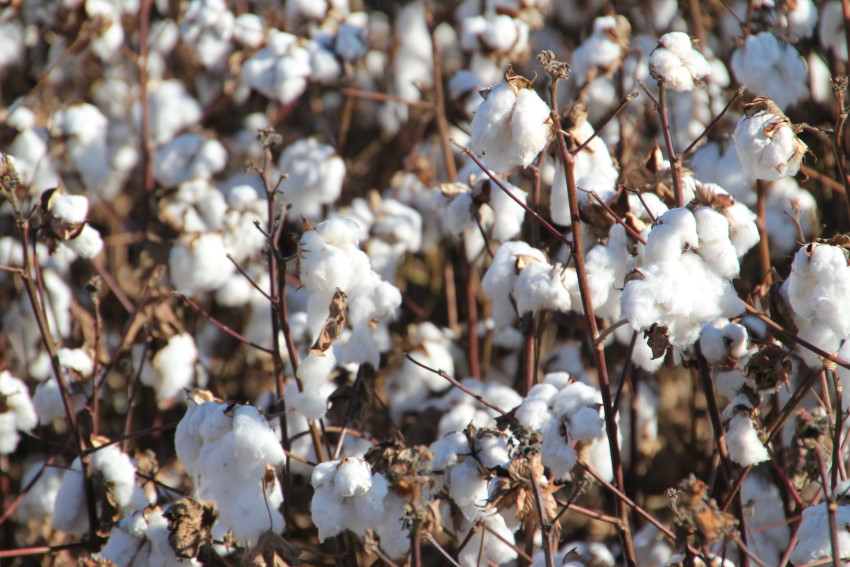
Agricultural News
Cotton Producers Intend to Plant Nine Million Acres This Spring- Up Six Percent From Year Ago Levels- Oklahoma Expects 14.4% Jump
Sun, 07 Feb 2016 15:16:25 CST
 U.S. cotton producers intend to plant 9.1 million cotton acres this spring, up 6.2 percent from 2015, according to the National Cotton Council's 35th Annual Early Season Planting Intentions Survey.
U.S. cotton producers intend to plant 9.1 million cotton acres this spring, up 6.2 percent from 2015, according to the National Cotton Council's 35th Annual Early Season Planting Intentions Survey.
Upland cotton intentions are 8.9 million acres, up 5.7 percent from 2015, while extra-long staple (ELS) intentions of 208,000 acres represent a 31.2 percent increase. The survey results were announced today at the NCC's 2016 Annual Meeting in Dallas, Texas.
In Oklahoma, the expectation is that cotton producers will add about 30,000 acres compared to what was planted in 2015- the NCC intentions show Oklahoma at 246,000 acres for this spring. That's a 14.4% jump from a year ago. Texas will also increase acres in 2016, with total acreage in the largest cotton growing state expected to top the five million acre level at 5.066 million acres. Overall, Texas cotton acreage is expected to increase by 5.6 percent with south Texas responsible for the statewide increase. The survey responses indicate that cotton growers expect to plant land that was idled in 2015 due to excessive moisture. Little change in acreage was indicated in the state's other regions.
Dr. Jody Campiche, the NCC's vice president Economics & Policy Analysis, said, "Planted acreage is just one of the factors that will determine supplies of cotton and cottonseed. Ultimately, weather, insect pressures and agronomic conditions play a significant role in determining crop size."
She said that with abandonment set at 11 percent for the United States, Cotton Belt harvested area totals 8.1 million acres. Using an average U.S. yield per harvested acre of 831 pounds generates a cotton crop of 14.0 million bales, with 13.4 million upland bales and 595,000 ELS bales.
The NCC questionnaire, mailed in mid-December 2015 to producers across the 17-state Cotton Belt, asked producers for the number of acres devoted to cotton and other crops in 2015 and the acres planned for the coming season. Survey responses were collected through mid-January.
Campiche noted, "History has shown that U.S. farmers respond to relative prices when making planting decisions. During the survey period, the cotton December futures contract averaged just under 65 cents per pound, which is very similar to year-ago levels. However, corn and soybean prices are 8-12 percent below year ago levels, so price ratios of cotton to competing crops are a bit more favorable than in 2015."
Survey respondents in the Southeast indicated a 5.1 percent decline, lowering the regional total to 2.1 million acres. Across the six states, the results are mixed with increased acreage in Alabama and Florida and a decrease for the other four states. The survey indicates more cotton in Alabama at the expense of wheat and soybeans. Florida's acreage almost exclusively is moving away from peanuts into more cotton. In Georgia, cotton acreage is expected to decline by 5.0 percent with corn and soybeans pulling acres from cotton. In South Carolina, cotton acreage is expected to decline by 13.5 percent with shifts to corn and soybeans. North Carolina is shifting to primarily soybeans and corn, while corn benefits from the modest decline in Virginia.
In the Mid-South, growers have demonstrated their ability to adjust acreage based on market signals, in particular, competing crops' relative prices. This year's survey results are no different with growers intending to plant 1.2 million acres, a 24.9 percent increase from the previous year. All the region's states are expected to increase cotton acreage. In Arkansas, Louisiana and Mississippi, respondents indicate a reduction in wheat, soybeans and the 'other crops' category. In Missouri, cotton acreage is expected to increase while declines are expected for corn, soybeans and 'other crops' acreage. In Tennessee, acreage of corn, wheat and 'other crops,' likely sorghum, is expected to move into cotton.
Southwest growers intend to plant 5.3 million cotton acres, a 6.1 percent increase. Increases in cotton area are expected in each of the three states. In Kansas, land is shifting away from wheat and grain sorghum. Oklahoma cotton acreage is expected to increase as wheat acreage declines. Overall, Texas cotton acreage is expected to increase by 5.6 percent with south Texas responsible for the statewide increase. The survey responses indicate that cotton growers expect to plant land that was idled in 2015 due to excessive moisture. Little change in acreage was indicated in the state's other regions.
Far West producers are expecting to plant 213,000 upland cotton acres a 24.4 percent increase from 2015. Arizona is responsible for the increase, with California and New Mexico acreage seeing slight declines. Arizona survey results suggest a shift from wheat and 'other crops' to cotton. Arizona growers also are expecting to plant 34.8 percent more ELS cotton. The increase in California ELS acreage in 2016 is likely the result of expectations of increased water allocations.
The survey responses indicate that the modest increase in cotton acreage is largely the result of weaker prices of competing crops and improved expectations for water and favorable planting-time weather. Comments from respondents underscored the very difficult financial conditions facing cotton producers. For the past two years, U.S. cotton producers have struggled with low cotton prices and high production costs and with current futures markets indicating steady prices, producers' economic situation is not likely to improve in 2016. Some producers, in fact, will find it very difficult to obtain production financing for the current year.
NCC delegates were reminded that these expectations are a snapshot of intentions based on market conditions at survey time. Actual plantings will be influenced by changing market conditions and weather.
WebReadyTM Powered by WireReady® NSI
Top Agricultural News
More Headlines...





